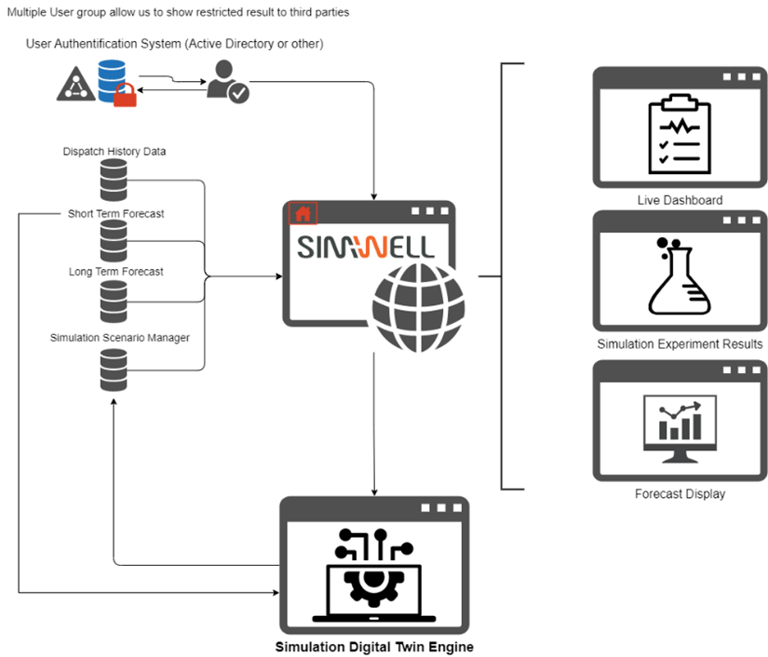The mining industry is undergoing transformative change. Amidst increasing demand and volatility across the globe, Value Chain Leaders are turning to innovative strategies to optimize their operations and maximize profitability. SimWell helps Value Chain Integrated Planning Teams take a holistic approach across ore logistics with Value Chain Integrated Planning (VCIP). VCIP is an industrial grade digital twin application that is tailored to the needs of the Value Chain Leader.
VCIP captures operations from the mine, plant, rail, and port terminal under one unified strategy to provide predictive planning that increases system level throughput while saving money across the operation.
Have A Complete Picture with Value Chain Integrated Planning
As a VCIP leader Imagine a seamless flow from the mine, through the concentrator and plant, via rail logistics, and finally to the port terminal and ship loading. By integrating the planning of these operations, miners can:
- Break the silos and optimize the value chain as a whole (rather than optimizing the mine, the plant, the concentrator, the rail, the port terminal, etc. independent from one another)
- Maximize global throughput
- Streamline decision-making for investments and operations.
But how do simulation, optimization, and digital twin technologies play into this?

Digital Twin: The Virtual Replica
The digital twin technology creates a dynamic virtual replica of physical mining operations. By integrating real-time data from various sources, these replicas provide, as a first step, a live view of operations, helping identify inefficiencies and opportunities for improvement.
However, the real power of a digital twin lies beyond the present. With simulation and optimization technologies, real-time data becomes the foundation for forecasting the future. Starting with current conditions a simulation model can predict the performance, find windows of opportunity for key maintenance, or anticipate production bottlenecks. In essence, real-time data, when properly harnessed, transforms from mere situational awareness to a crystal ball, enabling mining operations to be proactive, pre-empt challenges, adapt to evolving conditions, and chart a course for a future defined by efficiency and foresight.
Simulation for strategic decision – Predicting the outcome of CAPEX decisions
By creating a virtual model of the Value Chain, operators can predict the outcomes of various scenarios. Before committing significant capital towards new equipment or infrastructure, mining companies can simulate its impact to understand the ripple effects of a change in one part of the operation. For instance, an investment to increase the capacity of the plant may have no impact on the total throughput of the value chain if the bottleneck moves to another sector in the chain.
Simulating changes and predicting value chain outcomes aids in strategic decision-making, ensuring that investments align with long-term goals and yield desired returns.

Simulation for Tactical Decision – Predicting the Near Future and Comparing Alternative Scenarios
Simulation, in the realm of tactical decision-making for mining value chain, serves as a potent tool, offering a sneak peek into the near future. Rather than basing decisions on static past data, simulation harnesses current conditions to project imminent outcomes.
This ability to model the immediate future enables mining companies to evaluate a myriad of "what if" scenarios. Whether contemplating a shift in resource allocation or adjusting to sudden disruptions simulations present manager with a comparative landscape for their key decisions.
By visualizing and quantifying the implications of each alternative in real-time, coordinators can select the path that promises optimal efficiency, minimized risks, and maximized returns. In essence, simulation transforms the abstract nature of tactical choices into tangible, data-driven scenarios, ensuring decisions are both informed and forward-looking.
An example for mid-term planning includes predicting the volume to be produced in the next quarter and adjusting the ship schedule accordingly. Another example in short term planning is finding windows of opportunity to perform a maintenance due on a key asset (a crusher in the plant for instance) that minimizes impact on global throughput.

Optimization: Fine-Tuning Daily Logistics for Peak Performance
The daily challenges of mining logistics are multifaceted and complex. Especially in operations that involve rail logistics, orchestrating the ballet of locomotives, crew scheduling, and train timelines is critical. This is where optimization tools come into play, making what might seem like an intricate puzzle a solvable challenge with discernable patterns and solutions.
Let's delve into the daily logistics of a rail ore logistics operation, focusing on the locomotives. Every day, trains need to transport tons of ore from train loadout locations to ports. Each locomotive has its capacities, fuel needs, and maintenance schedules. Similarly, each crew member has their skill sets, working hours, and fatigue considerations. Beyond these, the schedule of each train, including its departure, transit, and arrival times, interacts dynamically with these factors. Lastly, trains meet one another on the track through sidings.
Using optimization tools, a rail managers can hone in on these details for precise daily planning. For instance, if a particular route sees more congestion in the early hours, the tool might recommend deploying a locomotive with faster unloading time during that window. Or, based on fatigue management principles and legal work limits, it might suggest the ideal shift rotations for crew members.
Moreover, the world constantly evolves. Unforeseen disruptions, such as a track obstruction or a sudden spike/delay in plant production, need immediate recalibrations in schedules to maximize throughput. Here, optimization models can instantly adjust the train schedules, ensuring that there are no bottlenecks in transportation, and the entire operation runs like a well-oiled machine.
In essence, for daily challenges like locomotive, crew, and train scheduling, optimization transforms an overwhelming web of decisions into a systematic, data-driven process. When the world change, plan can be adjusted faster. By doing so, mining operations can achieve unparalleled efficiency, reducing delays and maximizing productivity each day.
In Conclusion
Value Chain Integrated Planning in mining is not just about streamlining operations. It's about leveraging state-of-the-art technologies to make informed, strategic, tactical and operational decisions that can shape the future of mining enterprises. Whether it's making pivotal CAPEX investments, fine-tuning maintenance schedules, or optimizing daily operations, VCIP ensures that the mining value chain is set up to Maximize throughput every day.
About SimWell
We are here to take a holistic approach across ore logistics with Value Chain Integrated Planning (VCIP), as an industrial grade digital twin application that is tailored to your needs as the Value Chain Leader.
OR send me a note at aouellet@simwell.io

Alexandre Ouellet, CEO at SimWell





